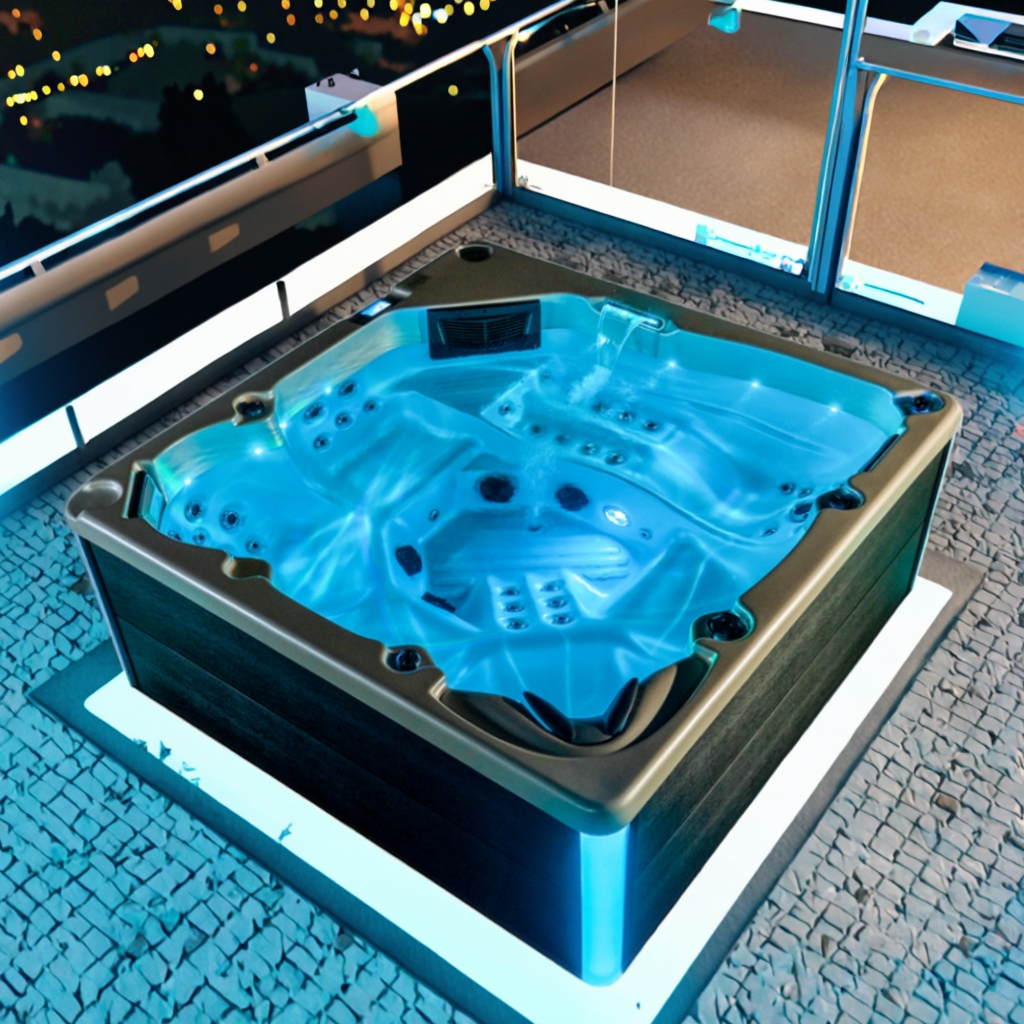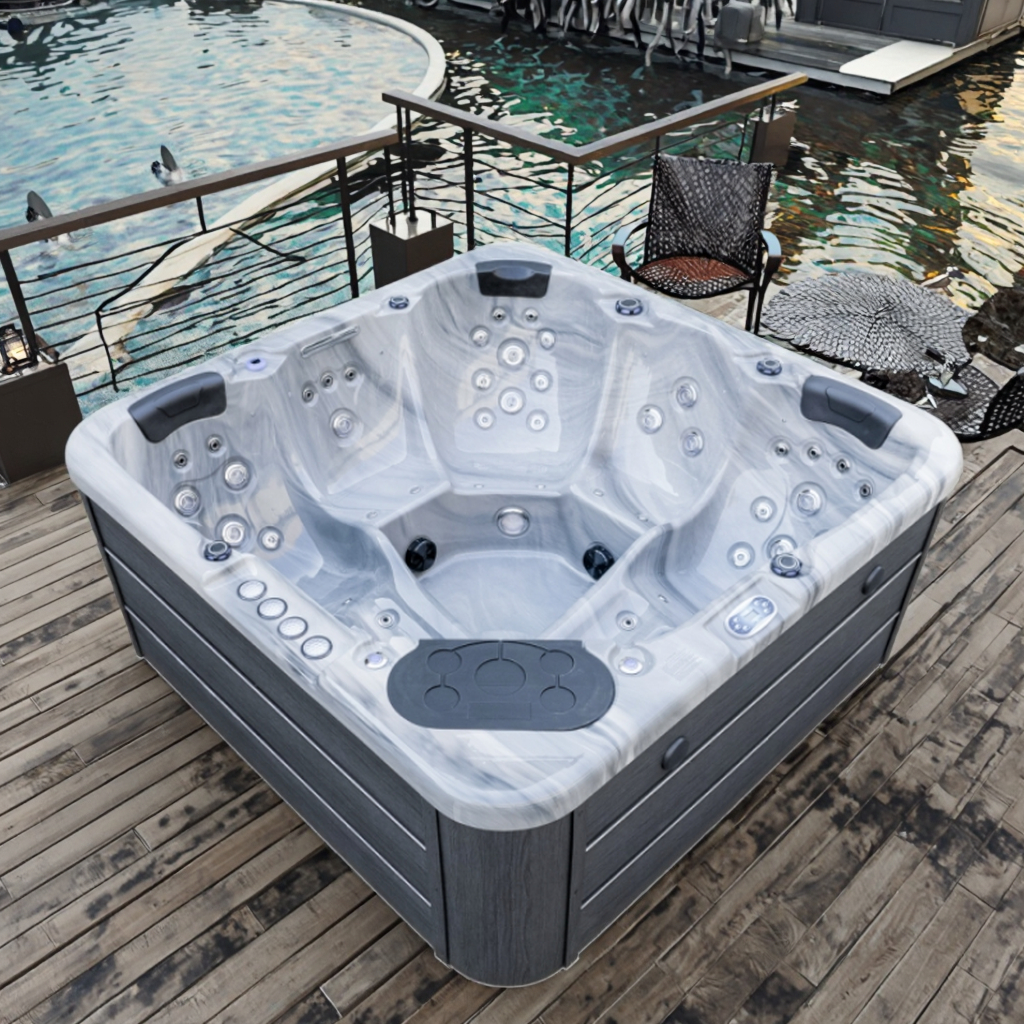
Does a High pH Level Cause Foaming in a Spa Jacuzzi Tub?
2025-11-18 15:30When using a spa jacuzzi tub, you might sometimes notice a layer of persistent foam on the surface. This phenomenon is often confusing: is it detergent residue? Is it too much grease? Actually, the pH level of the water can be a key factor.
Many people overlook the impact of pH on foam formation. Especially when the pH level of the spa jacuzzi tub is high, foam is more likely to appear, and may even be accompanied by problems such as cloudy water and dry skin. So, does a high pH level actually cause foaming in a spa jacuzzi tub? Why? And how should it be adjusted? This article will provide a detailed analysis.

Why is pH so important in a spa jacuzzi tub?
Before understanding whether a high pH level causes foaming, we first need to understand the meaning and function of pH.
1. What is pH?
pH is an indicator of the concentration of hydrogen ions in water, used to represent the acidity or alkalinity of the water.
• pH = 7 indicates neutral;
• pH < 7 indicates slightly acidic;
• pH > 7 indicates slightly alkaline.
In a spa jacuzzi tub, the ideal pH range is generally between 7.2 and 7.8. Water within this range will not irritate human skin and will ensure the activity of disinfectants (such as chlorine or bromine) and the normal operation of the equipment.
2. Why does pH affect a spa jacuzzi tub?
pH not only determines the chemical balance of water but also affects:
• Foam formation and stability;
• Water transparency and cleanliness;
• The effectiveness of disinfectants;
• Corrosion and scaling of metal parts in the equipment;
• User comfort and skin health.
Therefore, maintaining a suitable pH value is fundamental to the normal operation and experience of a spa jacuzzi tub.

Does a high pH value cause foaming in a spa jacuzzi tub?
The answer is: High pH doesn't directly create foam, but it significantly enhances the stability and persistence of foam, making spa jacuzzi tubs appear to foam more easily.
1. Foam is More Stable at High pH
Foam is a structure formed by the aggregation of tiny gas bubbles in a liquid. Its stability depends on the surface tension of the water, its chemical composition, and ion concentration.
When pH increases, the ion balance in the water is disrupted:
• Surfactants (such as soap residue and skin care oils) ionize more easily in an alkaline environment;
• Ionized molecules more effectively reduce the surface tension of the water;
•This makes bubbles easier to form and less likely to burst.
Therefore, even with low levels of contaminants, spa jacuzzi tubs with high pH are more likely to produce persistent foam.
2. High pH Reduces Disinfectant Effectiveness, Indirectly Increasing Foaming Substances
In an alkaline environment, the bactericidal efficiency of chlorine or bromine disinfectants decreases. This means that bacteria, algae, or organic residues in the water may increase, and these organic substances can enhance foam stability.
In other words, high pH causes a "secondary effect": decreased sterilization ability → accumulation of organic matter → increased foam generation.
3. The impact of excessively high pH on water chemical balance
When the pH exceeds 8.0, carbonates precipitate under heating conditions, forming tiny suspended particles. These particles adhere to the foam interface, making the foam stronger and harder to dissipate.
Therefore, high pH itself is not a "foam maker," but it is a "foam maintainer." In a highly alkaline environment, even slight oil or bath product residue can create a large amount of foam, which is more difficult to remove.

Why is the pH of a spa jacuzzi tub high?
To solve the problem, we must first understand the cause. An elevated pH in a spa jacuzzi tub is usually caused by the following factors:
1. Water evaporation and mineral concentration
With increased usage, water evaporates but minerals remain, increasing the concentration of calcium and magnesium ions, making the solution alkaline.
2. Using Alkaline Cleaners
Many cleaning products (especially non-specialized household cleaners) contain strong alkaline ingredients such as sodium hydroxide and sodium carbonate. If these residues remain in the system after cleaning, they can cause the pH value of the spa jacuzzi tub to rise rapidly.
3. Over-aeration and Circulation
When the circulation pump or jet system runs for extended periods, a large amount of air mixes into the water, and carbon dioxide escapes, disrupting the carbonic acid balance and causing the pH value to rise.
4. Using Alkaline Top-Up Water or Hard Water
Tap water or well water in some areas is naturally alkaline. If not softened or adjusted, long-term use in the bathtub can also lead to a high overall water pH.
5. Infrequent Maintenance or Infrequent Water Changes
Accumulated organic matter may consume acidic components during decomposition, gradually alkalizing the water.
What are the characteristics of foam caused by high pH values?
When the pH value of a spa jacuzzi tub remains consistently high, the foam often exhibits the following characteristics:
1. Fine and persistent foam
Unlike bubbles that dissipate quickly, foam in a highly alkaline environment forms a fine, dense, and stable layer that can persist for several minutes even after the water pump stops.
2. Whitish but slightly cloudy foam
The foam contains tiny mineral particles or oils, resulting in an opaque surface that appears milky white or light gray.
3. Slippery water with a slight floating oil film
Insufficient decomposition of surfactants and oils in the water makes it feel "slippery" and produces an iridescent oil film under light.
4. Reduced disinfectant odor or a slight off-odor
High pH inhibits the effectiveness of disinfectants, reducing the chlorine odor. If bacteria grow, an off-odor may appear.

Is foam just an appearance issue?
What other potential problems can high pH levels cause? Many users believe that foam is merely an aesthetic issue, but in fact, a high pH level can have multiple adverse effects on the entire spa jacuzzi tub system.
1. Effects on Human Health
• Dry and itchy skin: Alkaline water can damage the skin's natural protective film, leading to moisture loss.
• Eye irritation: High pH water can irritate the mucous membranes of the eyes.
• Respiratory discomfort: Aerosols in the foam may contain alkaline particles, causing mild irritation.
2. Effects on Equipment
• Scale and clogging: An alkaline environment promotes calcium and magnesium deposition, leading to nozzle clogging and uneven water flow.
• Increased burden on pumps and heaters: Increased water flow resistance shortens equipment lifespan.
• Sensor misreading: Alkaline water may interfere with some conductivity detection devices, leading to control errors.
3. Effects on Water Quality and Maintenance Costs
• Reduced disinfectant efficiency, requiring more frequent replenishment;
• Turbid water, requiring more frequent water changes;
• Increased cleaning, descaling, and pipe maintenance costs.
How to check if the pH of a spa jacuzzi tub is too high?
Maintaining good testing habits is key. The following methods can help determine if the pH of your spa jacuzzi tub is too high:
1. Use test strips or an electronic pH meter
Immerse the pH test strip in the water and use the color chart to read the value; or use an electronic pH meter for higher accuracy.
2. Observe water quality changes
A slippery feel, increased foaming, and decreased transparency are often accompanied by an increase in pH.
3. Measure total alkalinity
High total alkalinity usually coexists with high pH; both should be within the recommended range (alkalinity should generally be 80–120 ppm).
It is recommended to test 1–2 times per week. For frequently used spa jacuzzi tubs, the testing frequency can be increased.
How to adjust and lower the pH of a spa jacuzzi tub?
When a test shows that the pH is too high, measures should be taken promptly to restore balance.
1. Use a professional pH lowering agent
Most pH lowering agents are based on sodium bisulfite (NaHSO₄) or dilute hydrochloric acid. Dissolve a small amount of the agent according to the product instructions, pour it evenly into the water, run the circulation system for 10–15 minutes, and then retest.
2. Control aeration and circulation time
If excessive carbon dioxide escapes due to excessive circulation time, reduce the spray or bubble operation time appropriately.
3. Partial water change
If the overall water quality is unbalanced, drain some old water and add new water to dilute the alkalinity.
4. Check the cleaning and care products used
Avoid using highly alkaline detergents or soap-based bubble solutions; choose low-foaming, pH-neutral products specifically designed for spa jacuzzi tubs.
5. Regularly maintain the filtration system
Filters can adsorb residual chemicals and grease; if not cleaned for a long time, they will repeatedly release alkaline substances.
What Markets Does LOVIA SPA Export To?
LOVIA SPA exports to Europe, North America, Australia, Asia, and beyond. Our brand is trusted globally for its high quality, low price, and reliable factory support. Whether you’re purchasing for hotel resorts, retail shops, or online distribution, our products meet international standards and certifications.
Buyers enjoy flexible ordering, wholesale discounts, and regular promotional sales. With over 35 years of manufacturing and export experience, LOVIA SPA is a dependable supplier and manufacturer for global spa purchasing needs.
